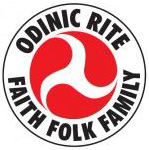Odinic Rite

TheOdinic Rite(OR) is areconstructionistreligious organisation named after the godOdin.It conceives itself as a "folkish"Heathenmovement concerned withGermanic paganism,mythology,folklore,andrunes.As awhite supremacistorganization, the Odinic Rite limits membership to white individuals, holding the belief in Heathenry as the ancestral religion of theIndo-European race.
Background
[edit]This section maylendundue weightto Alexander Rud Mills, and it remains unclear how or if he has influenced the Odinic Rite.Please help tocreate a more balanced presentation.Discuss andresolvethis issue before removing this message.(June 2023) |
The Odinic Rite refers to their form of Heathenry as "Odinism", a term favoured among Heathenwhite supremacists.[1]In 1841, the term was used by the Scottish writer, historian, and philosopher,Thomas Carlylein his book,On Heroes, Hero-Worship, & the Heroic in History:"Odinism was Valour; Christianism was humility, a nobler kind of Valour."[2]It was also used byOrestes Brownsonin his 1848Letter to Protestants.[3]

The term was re-introduced in the late 1930s byAlexander Rud Mills,an Australianfascist.[4]Having formulated "his own unique blend" ofAriosophy,[5]Mills drew heavily on writings of pioneering Austrian Ariosophist and WotanistGuido von List.[6]Much of Mills' ideology focused around what he conceived as the "British race", a group who he believed also inhabited not only Britain but other parts of the world colonised by theBritish Empire.[6]That concept was particularly problematic given the ethnically and linguistically diverse nature of the British population during the early 20th century.[6]Mills believed that while Christianity was alien to the "British race", Odinism was 'native' and thus could be better understood by them.[7]He expressed the view that "our own racial ideas and traditions (not those of others) are our best guide to health and national strength".[6]He was critical of Christianity, believing it to be "unnatural" because – in his view – it encouraged the breaking down of racial barriers.[6]In Mills' theology, the Norse gods were symbols of the divine rather than actual anthropomorphic entities, and he believed that each racial group had its own symbolic system for interpreting and understanding divinity.[6]For Mills, Odin represented an archetypal father figure, with other deities fromNorse mythology,such asThorandFrigg,having minor roles.[8]
History
[edit]In 1973 John Gibbs-Bailey (known as "Hoskuld" ) and John Yeowell (known as "Stubba", 1918–2010) founded theCommittee for the Restoration of the Odinic RiteorOdinist CommitteeinEngland.[9]Yeowell had been a member of theBritish Union of Fascistsin his youth and bodyguard to leaderOswald Mosley.[10]In 1980 the organisation changed its name toThe Odinic Riteafter it was believed that it had gained enough significant interest in the restoration of the Odinic faith.[citation needed]
In 1989 Yeowell resigned as Director of the Odinic Rite's governing body, theCourt of Gothar.The Court then unanimously elected Jeffrey Holley (known as "Heimgest" ) as its Director and he was officially installed in this position on 23 April 1989 at theWhite Horse StoneinKent.He was professed byFreya Aswynn.[11]Prior to his involvement with the Odinic Rite Heimgest had belonged to a small group known as the Heimdal League,[12]a closed group which disbanded in the mid-1980s.
Beliefs
[edit]The Odinic Rite defines Odinism as the natural religion of the peoples ofNorthern Europe.[13]It has been characterised as a white supremacist organisation and describes itself as a "folkish"group, which it states centres on a stance that includes" racial preservation and promotion ", and to" have as many healthy children as is practical ".[14][15]It asserts that "nationality is biological, not geographical",[15]further stating that "It is hardly possible to overestimate the damage that the destruction of racial and national identity has caused, to both people and the environment."[15]
They only allow white members and discouragemixed-race relationships,stating that while this was not a stance taken by heathens prior toChristianisation,this is a necessary precaution in the modern age to maintain "racial integrity" and to prevent "crossed allegiances".[15]The group further draws analogies betweeninvasive speciesandimmigrants,stating that the latterthreaten the survival of the white population.[15]It defines right and wrong as follows:
That which fulfils Nature, benefits the race as a servant of Nature, and benefits Odinism as a vehicle for the evolution of the race, is good; that which does not is bad. That which truly seeks and secures this good is right; that which does not is wrong.[15]
The Odinic Rite encourages its members to live their lives according to the "Nine Noble Virtues"and the"Nine Charges".The list of noble virtues (Courage,Truth,Honour,Fidelity,Discipline,Hospitality,Self-Reliance,Industriousness,andPerseverance) is attributed to either John Yeowell (a.k.a. Stubba) and John Gibbs-Bailey (a.k.a. Hoskuld), members of Odinic Rite; or alternatively toStephen Flowers(writing as 'Edred Thorsson'), at the time member of theAsatru Free Assembly.[16]
While the group nominally identifies as a religious organisation that is not political, the worldviews held by the group have been identified as belonging to theextreme-rightbased on their racial nationalism. It is noted, however, that this terminology wouldn't necessarily be used by members of the group.[17]
National branches
[edit]The Odinic Rite expanded in the 1990s with national branches in Germany, France, and North America.[18]The German chapter, Odinic Rite Deutschland (ORD), was formed in 1994.[19]In its early history the ORD was heavily influenced by Bernd Hicker who was its chairman for seven years.[20]It collaborated with the group Yggdrasil-Kreis in the 1990s; this group professed a "European religion of nature" and sought to combineGermanicandCeltic paganism.[21]
Due to concerns about connections between the British OR andfar-right politics,expressed already in 1995 in the ORD's member's magazine, as well as differing views of practice and organising, the ORD was established as an independent organisation in 2004.[22]It changed its name toVerein für germanisches Heidentum(VfgH;lit. 'Association for Germanic paganism') in 2006.[20]
In popular culture
[edit]In 1997 the Director of Gothar, Heimgest, chantedrunenames on theSol InvictusalbumThe Blade.[23]
See also
[edit]- Heathenry in the United Kingdom
- Heathenry in the United States
- List of magical organizations
- Modern paganism in the United Kingdom
References
[edit]- ^Johnson (2018).
- ^Wells (1991),p. 19.
- ^Berry (2017),p. 106.
- ^Berry (2017),p. 111.
- ^Asbjørn Jøn (1999),p. 77.
- ^abcdefAsbjørn Jøn (1999),p. 78.
- ^Asbjørn Jøn (1999),pp. 77–78.
- ^Asbjørn Jøn (1999),p. 80.
- ^Rudgley (2006),p. 240.
- ^von Schnurbein (2016),p. 57.
- ^Sannhet (1993).
- ^Rudgley (2006),p. 239.
- ^Barrett (2011),part 3.
- ^Sanchez (2009).
- ^abcdefAsbrandir AOR (n.d.).
- ^Snook (2015),pp. 70–72.
- ^White 2017,p. 242.
- ^Rudgley (2018),ch. 21.
- ^von Schnurbein (2016),p. 75.
- ^abKrebel (2014),p. 140.
- ^von Schnurbein (2016),p. 78.
- ^Krebel (2014),p. 140;von Schnurbein (2016),p. 75.
- ^Rik (1997).
Works cited
[edit]- Asbjørn Jøn, A. (1999). "'Skeggøld, Skálmöld; Vindöld, Vergöld': Alexander Rud Mills and the Ásatrú Faith in the New Age ".Australian Religion Studies Review.12(1): 77–83.
- Asbrandir AOR (n.d.)."What it means to be Folkish".Odinic-Rite.org.The Odinic Rite.Archivedfrom the original on 2022-12-06.Retrieved2022-12-16.
- Barrett, David V. (2011).A Brief Guide to Secret Religions: A Complete Guide to Hermetic, Pagan and Esoteric Beliefs.Running Press.ISBN978-0762441037.
- Berry, Damon T. (2017).Blood and Faith: Christianity in American White Nationalism.Syracuse University Press.ISBN978-0815635321.
- Johnson, Daryl (February 10, 2018)."Holy Hate: The Far Right's Radicalization of Religion".Intelligence Report.No. 2018 Spring Issue. Southern Poverty Law Center.Retrieved2022-12-15.
- Krebel, Sebastian (2014).Weil Gott die wunderbare Vielfalt liebt. Modernes Heidentum in Deutschland. Ethnographische Erkundungen[Because God loves the wonderful diversity. Modern paganism in Germany. Ethnographic explorations](PDF)(PhD) (in German).University of Erfurt.Retrieved16 December2022.
- Rik (7 May 1997)."Sol Invictus: The Blade".Fluxeuropa.com.Archived fromthe originalon 2007-03-16.
- Rudgley, Richard(2006).Pagan Resurrection.Century.ISBN0-7126-8096-9.
- Rudgley, Richard (2018).The Return of Odin: The Modern Renaissance of Pagan Imagination.Inner Traditions/Bear.ISBN978-1620557273.
- Sanchez, Casey (August 21, 2009)."Supreme Court Requires Prisons Give Special Consideration to Racist Pagans".Intelligence Report.No. 2009 Fall Issue.Retrieved2022-12-15– via Southern Poverty Law Center.
- Sannhet, Thor (January 1, 1993)."Exclusive interview with Freya Aswynn, author of Leaves of Yggdrasil".Vor Tru Magazine.No. Winter 1993.Retrieved2022-12-16– via Aswynn.com.
- Snook, Jennifer (2015).American Heathens: The Politics of Identity in a Pagan Religious Movement.Temple University Press.
- von Schnurbein, S. (2016). "Creating a Religion: The Emergence and Development of Late Twentieth-Century Asatru".Norse Revival: Transformations of Germanic Neopaganism.Brill. pp. 54–87.JSTOR10.1163/j.ctt1w76v8x.10.
- Wells, John (1991).Rude Words: A Discursive History of the London Library.London: Macmillan.ISBN978-0333475195.
- White, Ethan Doyle (2017)."Northern Gods for Northern Folk: Racial Identity and Right-wing Ideology among Britain's Folkish Heathens".Journal of Religion in Europe.10(3): 241–273.doi:10.1163/18748929-01003001.ISSN1874-8929.
Further reading
[edit]- Weber, Shannon (February 1, 2018)."White Supremacy's Old Gods: The Far Right and Neopaganism".Political Research Associates.Retrieved2022-12-15.
